Gold & Precious Metals
- The rally in gold that began in January has stunned most money managers. They were predicting a horrible year for gold in 2014, and a great year for US stock markets.
- So far, they are dead wrong.
- The Dow has gained no ground, while gold, silver, and precious metal stocks have performed like champions.
- From a fundamental perspective, the main sources of gold demand are Indian and Chinese gold jewellery buyers, Western retail clients, institutional money managers, and central banks.
- What of these sources of demand is responsible for the current “steady as she goes” gold price rally?
- Well, the daily change in gold held by the SPDR gold fund is a superb indicator of Western liquidity flows into and out of gold bullion.
- Please click here now . I’ve highlighted the daily change in SPDR tonnage in this table. For the month of January, the holdings were essentially unchanged. While they were not a negative factor, Western ETF buyers were clearly not the key driver of the January gold market rally.
- Please click here now . That’s a look at SPDR tonnage for the month of February. It increased by about 20 tons. That’s a decent jump, but mine and scrap supply amount to more than 300 tons a month, so investors need to look at other sources of demand, for the main key to this rally, and to understand whether it can continue.
- Official central bank holdings don’t appear to have changed much in 2014. China seems to have imported about 80 tons in January, and probably produced about 30 – 40 tons internally. Demand is definitely very strong in China, but it doesn’t exceed global supply.
- Please click here now . That’s the COT report for December 31, 2013. Next, please click here now . That’s the most recent COT report available.
- Over the recent two month period, hedge funds appear to have increased their long position by about 50,000 contracts (roughly 150 tons), but commercial traders have increased their short position substantially.
- The bottom line is that hedge fund buying is strong, but when balanced against commercial selling and shorting, it was not the factor that moved the gold price substantially higher.
- Please click here now . Mineweb reports that Mumbai traders believe official Indian imports for January were in the 40 ton area. That’s definitely not enough to overwhelm supply.
- The Central Bank of India and the World Gold Council (WGC) have both indicated that gold smuggling could quickly become a major issue in that nation, like it was in the 1990s. The WGC has estimated that perhaps 200 tons of gold were smuggled into the country in 2013.
- That’s a significant number, and I would argue most of that probably occurred in the second half of the year, after the Indian government and central bank imposed draconian import restrictions during the first half of the year.
- The bottom line is that smuggled gold going into India in 2013 probably did so at the staggering rate of about 40 tons a month. In my professional opinion, that number is probably still rising, and it could go even higher in 2014.
- I believe that most of investors in the Western gold community would agree that gold feels solid here. It feels like a mysterious floor of substantial demand is supporting the market on all sell-offs, yet the source of that demand is opaque.
- Many technical indicators on both the daily and weekly charts are flashing sell signals at nosebleed levels, yet gold refuses to slide in a material way. Is it possible that Indians have lost patience with broken government promises to lessen the draconian gold import duties? I think so.
- Gold is off to another great start this morning. To view the daily gold chart, please click here now . Despite being at nosebleed levels, my stokeillator at the bottom of the chart seems to be trying to flash afresh buy signal.
- A number of lead technicians at major banks have suggested that if gold rises above $1361, it could quickly surge to $1432. I think it would hesitate in the $1375 area, but $1432 is a critical number. If gold rises above the highs in the $1432 area, it would probably attract enormous institutional interest.
- Institutional money managers are more concerned about inflation now than financial system risk. That means they are likely inclined to buy gold stocks rather than bullion. So far in 2014, gold stocks are dramatically outperforming gold, and I think that outperformance has barely started.
- Until now, I’ve always been able to identify the fundamental source of demand that has created gold market rallies. It’s unknown whether Indian black market demand is the prime driver of the current gold market rally, but none of the other catalysts seem to be producing that kind of demand.
- The motto of the Indian Bullion and Jewellery Association (IBJA) is “We, The Team”. Is gold entering a new era, where Chinese and Indian gold jewellery demand for gold bullion combine with Western gold community mining stocks, creating a long-term rise in the price of both asset classes?
- On that note, please click here now . Note the incredible symmetry between the two congestion patterns on this daily GDX chart. There was a powerful momentum-style buy signal generated by the stokeillator as gold stocks began to rally out of the first pattern. Is it about to happen again? I think so, and I hope the Western gold community is fully poised to profit handsomely!
Mar 11, 2014
Stewart Thomson
Graceland Updates
website: www.gracelandupdates.com
email for questions: stewart@gracelandupdates.com
email to request the free reports: freereports@gracelandupdates.com\

Cheap Silver
Posted by Bob Moriarty - 321Gold.com
on Monday, 10 March 2014 17:54
 This is a Junior Mining Company that Bob Moriarty of 321Gold thinks is both undervalued and highly valued by sopisticated investors.
This is a Junior Mining Company that Bob Moriarty of 321Gold thinks is both undervalued and highly valued by sopisticated investors.
Specifically, Soltoro Ltd has 77 million ounces of silver in the ground at its El Rayo project, which works out to 1.1 ounces of silver per share or about $.15 an ounce for silver in the ground. As for sophisticated investors, a major Mexican billionaire controls over 14% of the stockm Directors and management control over 7% and Coeur D’Alene Mines owns about 7% of this company – Money Talks
Read more about the Company and its prospects HERE
Although Bob Moriarty thinks this company is positioned to go much higher, keep in mind that it is still an exploration company and not yet a producing company. In short this is a high risk situation.

The Real Fireworks Begin at the Cycle Bottom
Posted by Toby Connor - GoldScents
on Monday, 10 March 2014 14:29
This Week in the Gold Market
Trying to predict short term direction is notoriously difficult, especially in the volatile metals market, but I’m going to take a stab at it today.
First off let me start with the big picture: For almost a year now I’ve been saying that the inflation that’s been stored in the stock market for the last three years is eventually going to start leaking into the commodity markets. You can see in the next chart that process has begun as smart money investors begin to move capital out of an overvalued and overextended stock market that is destined to top some time during the first half of this year, and into undervalued commodity markets where they are getting a better return on their investment.
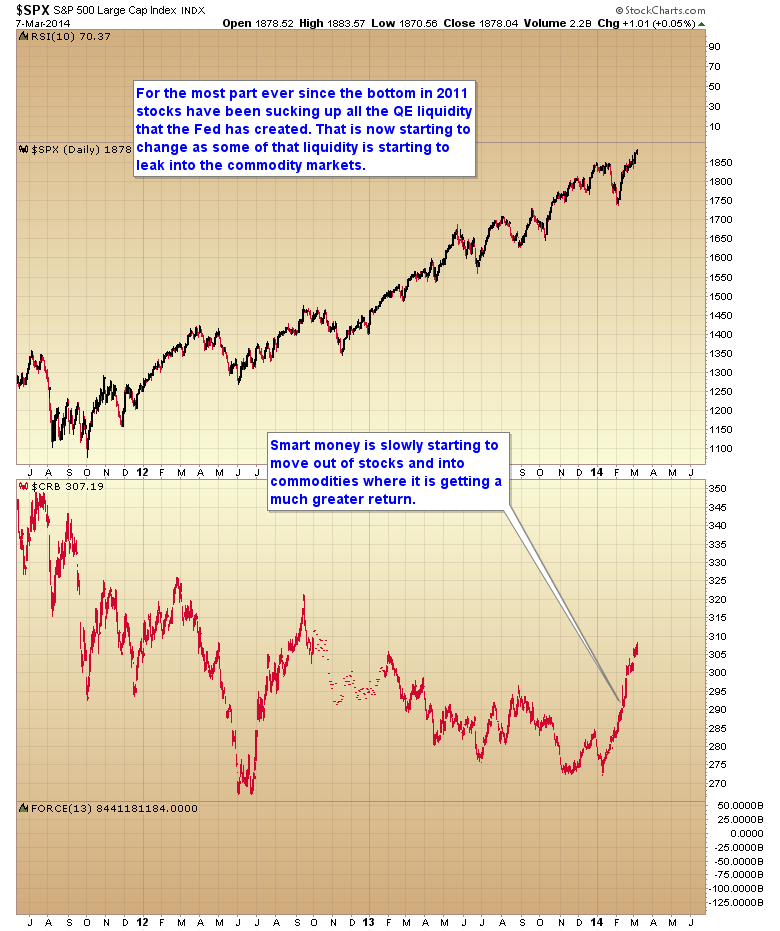
While the stock market is up 10% over the last month and a half, the CRB is up 12%. But that’s not the whole story. Gold is up 14% in the last two months, oil 15%, wheat 20%, corn 23%, sugar 27%, and the big winners, coffee at 90%, and natural gas at one point over 100%.
These kind of gains are going to draw more and more capital away from the stock market, at least until commodities form an intermediate top (probably around the first or second week of April). Yes this kind of explosive rally is going to have some kind of corrective move later this spring, but I don’t think the rally is done just yet. I’m looking for an acceleration of the move in March to at least test the 2012 high at 320 on the CRB index before commodities enter a multi-week correction/consolidation phase in April and May.
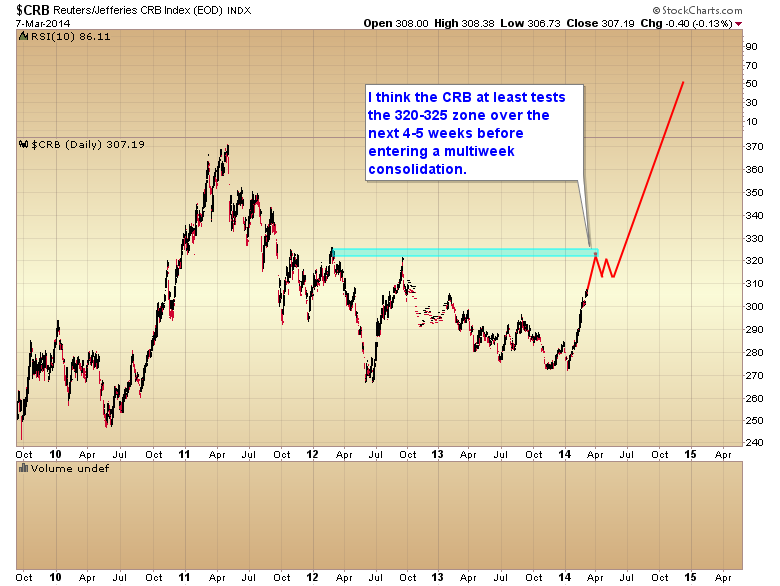
Next week has the potential to begin this acceleration phase if a couple of things fall into place. First off I think we need to see the dollar continue down into its next daily cycle low, potentially on the March 19 FOMC meeting.
I’ve also taken the liberty of extrapolating on the chart my expectations for the dollar index over the next month as it moves into an intermediate degree bottom.
If I’m right about the next week and a half, then I’m looking for the dollar to drop down and test the October low between now and March 19. As that level is a major support zone I think we will probably get a strong enough bounce at that point to produce a daily cycle low. However, considering that this intermediate cycle topped on week two I don’t think this intermediate decline will be done until the dollar breaks below that October bottom, producing a failed intermediate cycle. So I’m going to look for a shortened daily cycle during the second half of March with a final intermediate bottom probably on the April jobs report.
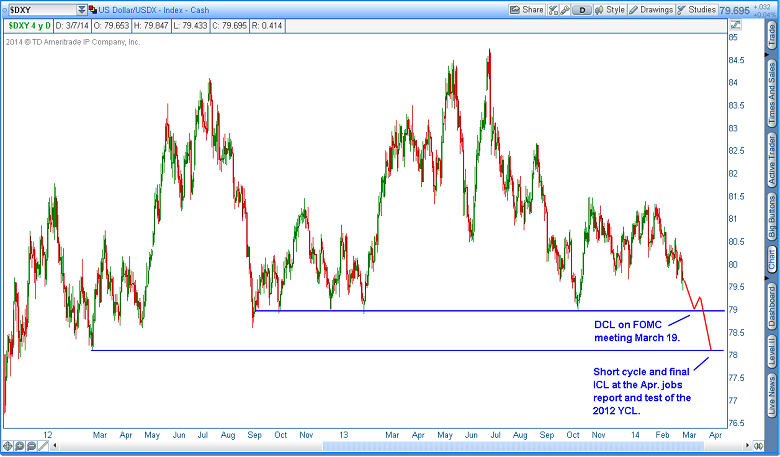
With the January and February employment reports coming in very weak, and the March report respectable at 175,000, I think the market is going to want to see confirmation from the April report before the intermediate trend in the dollar reverses.
Make no mistake, currencies are what is driving the commodity markets, not demand, and I don’t expect them to top until the dollar index finds its intermediate bottom.
While it’s not absolutely necessary, it probably wouldn’t hurt if the stock market were to drop down into a half cycle low over the next week and divert some buying pressure into the commodity markets as well. If Ukraine concerns were to flare up again this weekend that could presumably tip stocks over into a mild corrective event for a few days. I’m not sure last Monday’s one-day drop qualifies as a true and complete move into a half cycle correction. If that’s the case then next week would fit the timing band perfectly for this minor profit taking event that usually occurs around day 18-25 in the stock market daily cycle. (Monday will be day 21.)
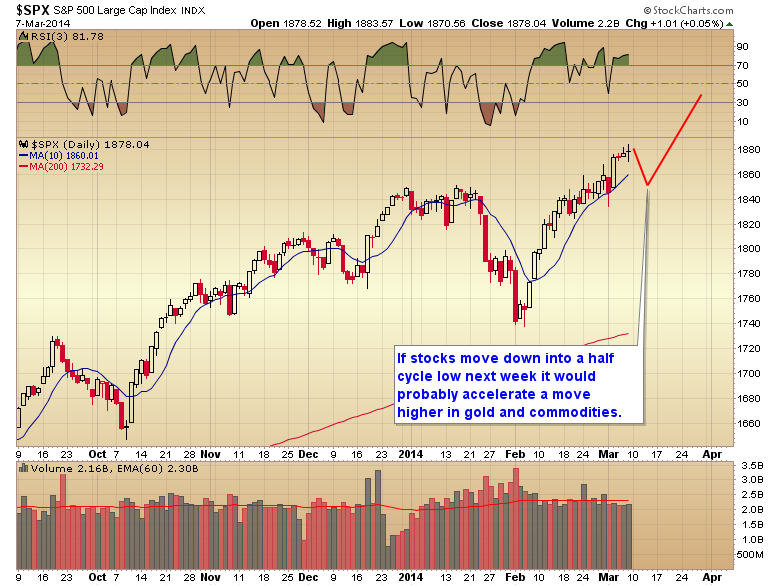
So how does this all tie in to next week’s move in gold you ask?
Well, if the dollar continues to drop into its daily cycle low over the next 8-10 days, and especially if the stock market lends a bit of a boost by falling into a half cycle low, I think gold should break through this resistance zone at $1350 and move up to the $1380-$1400 level over the next week and a half.
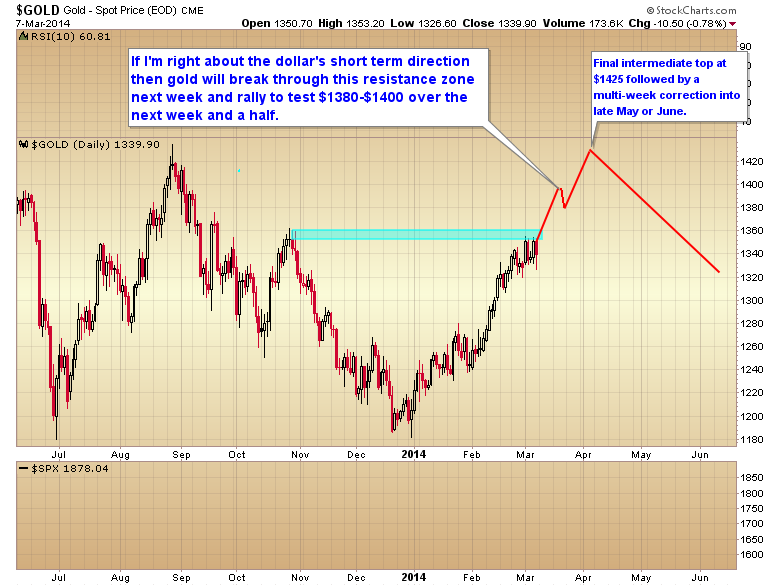
Then assuming that I’m right about a short dollar cycle into the April jobs report, gold should finish its intermediate rally with a test, or marginal break above the $1425 resistance zone in early April before dropping down into a multi-week correction that should form a yearly cycle low sometime in late May to early June.
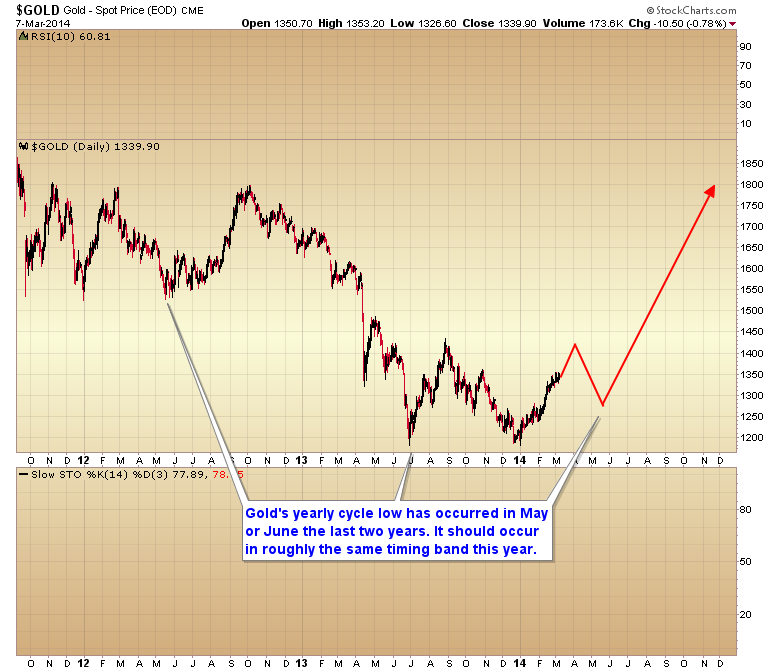
It’s the move out of that yearly cycle bottom this summer where the real fireworks are going to begin in the commodity and metals complex. I’ll have more on that in later articles.

“Bear markets are like sales,” Like finding a brand new Lexus at a dealer marked at 75% off. – Rick Rule
Gold Is on Sale for 75% Off
Sean Brodrick, Resource Strategist
This week I attended the Prospectors and Developers Association of Canada, the world’s biggest mining conference. And I found bargains galore… bargains that you can scoop up.
To be sure, mine is a contrarian view. Gold and silver miners have been in a bear market for years now. They’re far from their highs. It’s fair to say that Wall Street hates miners right now.
But have the underlying fundamentals on gold and silver changed? Nope. Demand continues to be strong, and supply weak.
And as gold prices came down last year, miners and developers refigured their projects and turned over every rock to find a dollar. Sure, some companies went belly up. But that just means that other companies got to pick up great projects for a song.
So we now have low-cost miners and developers that picked up projects on the cheap, run by guys who know how to squeeze a dollar until it screams. The best ones not only are going to make money – but are going to make a lot of money
Supply Squeeze
And as I’ve learned here in Canada, that long bear market meant a lot of potential gold projects were deferred. Jeffrey Christian of CPM Group told us that about a third of mining projects scheduled for development at the beginning of last year have now been shelved.
That means future supply will be squeezed. And so those miners who have working projects and can make money now are bargains.
Someone who gets the positive reality underlying all the doom and gloom is Rick Rule, chairman of Sprott U.S. Holdings.
“Bear markets are like sales,” Rule said. And he compared the low prices in select miners right now to walking onto a car dealer’s lot and finding every Lexus marked at 75% off.
“If someone lowered the price of a Lexus by 75%, would that make you less likely to buy it?” he asked. “Wouldn’t you like to buy a Lexus at 75% off?”
Rule says the market has been de-risked. And that really raises the opportunities for upside. “You’ve been here through the pain,” he added. “Why not stick around for the gain?”
I’m coming back from Canada with new recommendations for my subscribers. If the market is 75% de-risked, as Rick Rule says – and I agree with him on that – then I’d say the odds are these stocks are going to do all right.
In fact, I’d say the bigger risk is doing nothing. Sitting on your hands could cost you a lot of money.
All the best,
Sean
Ed Note: Sean is the author of: The Ultimate Suburban Survivalist Guide: The Smartest Money Moves to Prepare for Any Crisis – as well as a website: Gold & Resource Trader

Gold And Gold Equities: Is The Sector Turning?
Posted by Martin Murenbeeld - Chief Economist, Dundee Capital Markets
on Saturday, 8 March 2014 17:55
Summary
- The outlook for the gold price has improved in recent weeks; the stage is set for a recovery in the gold sector this year and next.
- The investment and speculative move against gold in 2013 will not likely be repeated in 2014 or 2015.
- If there is not net ETF selling this year and Asian demand persists then the gold price will rise.
- The gold sector is currently undervalued; this coupled with the outlook for a rising gold price makes the sector very attractive.
The gold price, the S&P/TSX Gold sub-sector, and the Philly XAU index of 30 gold/silver equities (Charts 1-3 below) suggest that the gold sector is turning a corner: gold bullion has broken upwards through its 200-day moving average, and both the S&P/TSX Gold sub-sector and the XAU have broken up through their 52-week moving averages. Technical analysts tell us these are good signs!



In our econometric work on the monthly valuation of equity sub-sectors we have determined that the S&P/TSX Gold sub-sector is seriously undervalued. The ratio of the Gold sub-sector to the S&P/TSX Index is near a new low and the ratio of the Gold sub-sector to the S&P/TSX Index less the Materials sector (the Gold sub-sector is an important component of the Materials sector) is at a new low, see Chart 4.
An econometric model of the latter ratio, which includes variables such as the gold price, interest rates and energy prices (as energy prices rise the Energy sector will rise and affect the relative value of the Gold sub-sector), indicates furthermore that the Gold sub-sector is now seriously undervalued in terms of the S&P/TSX Index less the Materials sector – see Chart 5. (The econometric analysis is a relative analysis, meant to encourage/discourage an overweight/underweight position in a specific sector.) In short, the econometric analysis currently recommends, all else equal, an overweight position in the Gold sub-sector.


A similar recommendation emerges when the S&P/TSX Gold sub-sector and the XAU index are compared with only the gold price. This less sophisticated analysis of the gold equity to gold bullion ratio – see Charts 6-9 – indicates that the gold equity to gold bullion ratios are currently well below long-term and short-term trends, and in one case more than two standard deviations below trend.
Neither the econometric analysis nor the equity/bullion ratio analysis include firm-specific variables; the investor must therefore establish whether there is indeed any value at all in the gold equity sector. This will require consultation with financial advisors and gold equity analysts – the latter concentrate on firm-specific variables.
My objective here however is to point out that the stage may be set for a recovery in the gold sector this year and next. The gold sector has been savaged in recent years on account of tumbling gold prices and unattractive firm-specific variables. But the outlook for gold prices has improved in recent weeks; many heretofore bearish observers have revised their near-term forecasts upwards and the “speculators” on COMEX have begun to build their net-long positions once again.
With respect to gold prices specifically, our view is that demand and supply will be the important issues in 2014 and 2015. Normally we’d be suggesting that international liquidity, inflation (or the lack thereof), Fed tapering, real interest rates, the trend of the US dollar, etc. are the key factors on which to focus. And indeed these will still be very important factors in 2014 and 2015. But last year, 2013, saw a dramatic decline in ETF gold holdings – 881 tonnes according to the latest data from the World Gold Council. (And “speculators” on COMEX reduced their net-long positions by over 195 thousand contracts between October 2012 and August 2013, which is the equivalent of 607 tonnes of gold.) In short, 2013 saw a phenomenal, never before recorded, investment and speculative move against gold.
One can think of the 881 tonnes of ETF gold sales as a reduction in investment demand (see Chart 10 overleaf where ETF sales are commingled with bar and coin demand), or as outright ETF supply (see Chart 11). Either way, the 881 tonnes of ETF sales had to be absorbed in the market – by way of more jewelry demand, more bar and coin demand, more official demand, more unrecorded offtake in India (i.e., smuggling), or by way of other forms of identifiable/unidentifiable demand.
(The collapse of speculative long positions in 2013 on COMEX does not have an easily identifiable equivalent tonnage of outright physical sales, but it wouldn’t surprise me if there were 50-100 tonnes of physical supply generated in one form or another as a result of the closing out of net long positions in 2013.)
The key question for 2014 is: will there be a repeat of ETF selling amounting to 881 tonnes in 2014? If the answer is no, and we think that is the right answer, then all other things constant the price of gold will have to rise in order to choke back demand to the available supply.
Not all else will be constant, of course. But 881 tonnes (and an unknown COMEX-related tonnage) add up to a lot of tonnes of gold. If central banks do not buy gold in 2014 for example, that would only remove an estimated 369 tonnes of demand from the market – less than half the ETF sales in 2013. I think there may be no net selling at all from the ETF sector in 2014; if I am right then 881 tonnes of ETF supply need to be made up from elsewhere or, assuming Asian demand parameters do not change dramatically, the price of gold must rise.
In short, developments in the gold sector are starting to look very interesting again; equities are “depressed” by our measures and the gold price is likely – though nothing is certain – to bottom out this year. Given that our long-term outlook for gold bullion has not changed appreciably we think the reader might wish to have a closer look at the gold sector once again.






About Dr. Murenbeeld
For Dundee Capital Markets Website go HERE


-
I know Mike is a very solid investor and respect his opinions very much. So if he says pay attention to this or that - I will.
~ Dale G.
-
I've started managing my own investments so view Michael's site as a one-stop shop from which to get information and perspectives.
~ Dave E.
-
Michael offers easy reading, honest, common sense information that anyone can use in a practical manner.
~ der_al.
-
A sane voice in a scrambled investment world.
~ Ed R.
Inside Edge Pro Contributors

Greg Weldon

Josef Schachter

Tyler Bollhorn

Ryan Irvine

Paul Beattie

Martin Straith

Patrick Ceresna

Mark Leibovit

James Thorne

Victor Adair
